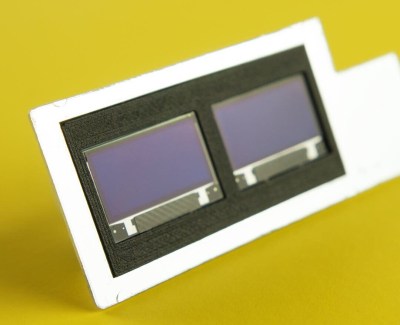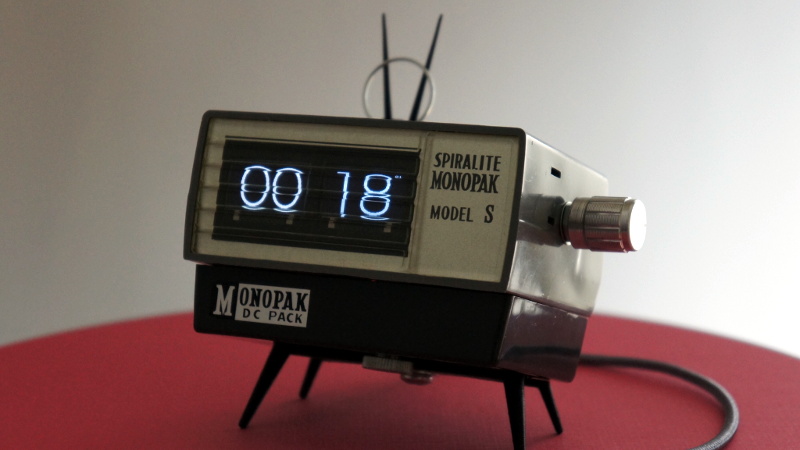After covering a few of his builds at this point, we think it’s abundantly clear that [Igor Afanasyev] has a keen eye for turning random pieces of antiquated hardware into something that’s equal parts functional and gorgeous. He retains the aspects of the original which give it that unmistakable vintage look, while very slickly integrating modern components and features. His work is getting awfully close to becoming some kind of new art form, but we’re certainly not complaining.
 His latest creation takes an old-school “Monopak” electronic flash module and turns it into a desk clock that somehow also manages to look like a vintage television set. The OLED displays glowing behind the original flash diffuser create an awesome visual effect which really sells the whole look; as if the display is some hitherto undiscovered nixie variant.
His latest creation takes an old-school “Monopak” electronic flash module and turns it into a desk clock that somehow also manages to look like a vintage television set. The OLED displays glowing behind the original flash diffuser create an awesome visual effect which really sells the whole look; as if the display is some hitherto undiscovered nixie variant.
On the technical side of things, there’s really not much to this particular build. Utilizing two extremely common SSD1306 OLED displays in a 3D printed holder along with an Arduino to drive them, the electronics are quite simple. There’s a rotary encoder on the side to set the time, though it would have been nice to see an RTC module added into the mix for better accuracy. Or perhaps even switch over to the ESP8266 so the clock could update itself from the Internet. But on this build we get the impression [Igor] was more interested in playing with the aesthetics of the final piece than fiddling with the internals, which is hard to argue with when it looks this cool.
Noticing the flash had a sort of classic TV set feel to it, [Igor] took the time to 3D print some detail pieces which really complete the look. The feet on the bottom not only hold the clock at a comfortable viewing angle, but perfectly echo the retro-futuristic look of 50s and 60s consumer electronics. He even went through the trouble of printing a little antenna to fit into the top hot shoe, complete with a metal ring salvaged from a key-chain.
Late last year we were impressed with the effort [Igor] put into creating a retro Raspberry Pi terminal from a legitimate piece of 1970’s laboratory equipment, and more recently his modern take on the lowly cassette player got plenty of debate going. We can’t wait to see what he comes up with next.
















Oh man that is just so pretty. This has to be made into a tiny HDTV, just has to be!
That particular color of blue-white makes me think P4 phosphor monochrome CRT
> RTC module added into the mix for better accuracy.
Your statement is incorrect. Accuracy *depends* on the accuracy of the RTC module itself. There are some accurate RTC chips with integrated TCXO crystals. The random RTC module from aliexpress with external crystal and cheap ceramic caps aren’t going to cut it.
One can achieve accuracy by calibrating and compensating for temperature in firmware too.
Even the worst RTC module on eBay is going to be better than counting ticks on the Arduino, so your counterpoint doesn’t make any sense.
All you need is a single counter example to prove such a generalize statement false.
Some of the EZ430 Chronos community get their calibration to +/- 5 seconds per year using calibration and software temperature compensation. I really don’t care about about arduino.
The worse RTC module is one with a crappy watch crystal and some brown capacitors which are not likely NPO and there are no trims. I got one of those. Chances are that the crystals aren’t 20ppm and more likely it would be a 100ppm Chinese junk part.
For a 100ppm part, that’s about 8.64 seconds per day. A 20ppm part gets you to 1.728 sec/day
I have implemented a RTC using 12MHz crystal and trimming the reload value for a 16-bit hardware timer. Without even trying hard, I get a 1/60000 trim which gets to 16.7ppm which is 1.44 sec/day just by playing with the values less than a week. The resolution can be much improved by using a phase accumulator.
I already beaten a RTC module.
Well; the best mechanical clock running in free air attains an accuracy of 0.625 seconds per day, so I would imagine any calculations would start there. RTC modules and mechanical clocks share the same accuracy characteristics, in the sense that they can both be found with abysmal accuracy, and tremendous accuracy. The constructor has to decide where on the spectrum they want their project to end up, from poor to outstanding. It’s a free choice. But accuracy costs.